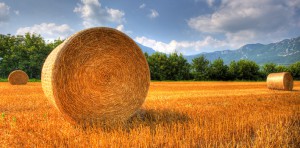Soil structure is a much neglected aspect of grassland management. Water availability can be a prime limiting factor in grass growth. Either too little or too much cause’s restriction in output and corrective action may be needed. An assessment of the soil type, structure, should be made in order to identify and rectify any problems at an early stage. It is important to maintain a good firm, well-drained soil. Land should be sub soiled if compaction occurs and gateways and bare areas should be patched up. Heavy machinery should not be used in wet or waterlogged fields. When working the land continuously using heavy forage equipment, try and use different wheeling’s to avoid localised compaction, which is difficult to correct. It is also important not to allow poaching by grazing stock in wet conditions.
Fields should be tested regularly to check the pH and nutrient status of the soil. Although this may seem costly it is money well spent .It is advisable for optimum production and should be carried out at least every 3 years. The optimum pH for good grass and clover growth is 6-6.5.If the pH falls below 6, lime should be applied. If the pH is not corrected, the fertilizer applied will not give their optimum performance.
All growing crops require nutrients throughout the growing season. Nitrogen is the most important nutrient and is responsible for protein production as well as producing chlorophyll within the grass. Phosphate is important for the development of roots and tiller survival. Potash is involved in a number of functions including protein production and the efficiency of photosynthesis. Too much potash will suppress the uptake of magnesium in cattle and sheep causing “grass staggers” (hypomagnesaemia).It is therefore important that potash is not applied before spring grazing. The amount of potash required is determined by soil type; clay soils having greater available soil reserves than sandy soils.
It is now time to assess the presence of weeds in the sward and choose the correct product to control the problem.
Cow parsley is becoming an increasing problem weed it will grow in sunny to semi-shaded locations in fields and at the edges of hedgerows and woodland. It is a particularly common sight by the roadside. It is sufficiently common and fast-growing to be considered a nuisance weed. Cow parsley’s ability to grow rapidly through rhizomes and to produce large quantities of seeds in a single growing season has made it an invasive species in many areas of Northern Ireland. GRAZON PRO will give very good control of cow parsley.
DOCKS
Although grass growth has been reasonably good and weeds seem to be at their optimum timing I would hold off spraying until day and night conditions are consistent. Hopefully conditions over the next few weeks will provide an opportunity to get a start made to weed control. As thoughts turn to silaging, treating dock-ridden leys with DOXSTARPRO four weeks before cutting will significantly increase the amount of grass that ends up in the clamp and improve silage quality. Docks have much less feed value than grass and pull down dry matter. FOREFRONT T is the most effective herbicide available to grassland farmers for the control of docks, ragwort, chickweed, thistles, dandelions, nettles and buttercups. It is the longest lasting weed control product in grassland to date with a single well timed spray giving up to 18 months control so whilst it may appear expensive it really is good value for money.
Once the established docks have been controlled it is best to keep the problem under control with follow-up treatments every year. This controls new growth of seedling docks that will reappear because all that is required for dormant seeds to germinate is a gap in the sward caused by poaching or tractor marks.
No dock spray will give complete control with a single application – effective dock control requires a programmed approach, follow-up applications to deal with docks and germinating seed docks not controlled in the first treatment. Long term control can only be achieved using a sequence of applications of a translocated herbicide because of the potential for regrowth both from roots and the seed bank built up in the ground over the years.
In fertile soils, the dock root system consists of a large tap root with a highly branched mass of smaller fibrous roots. This means what appears to be a small dock plant above ground may in fact be growing from a large rooting system below ground. In order to achieve effective herbicide application docks should be at the rosette stage, with foliage8-10 inches high or across. If grass has been cut or grazed a period of three weeks must occur to allow sufficient regrowth and a suitable target for spraying. If applying FOREFRONT T, DOXSTARPRO or PASTOR, livestock should be kept out of treated areas for 7 days before grazing and until the foliage of any poisonous weeds has died and become unpalatable
Where clover is important SQUIRE ULTRAmay be applied.
THISTLE
The Creeping Thistle is a perennial which grows from seed or from root sections in the soil. Once established the root mass can be greater than the plant above ground hence competing effectively with the grass. The Spear (Buck or Scotch) thistle is a biennial plant which grows from seed. In the first year it produces a small rosette, and then in the second year the plant can grow to over 1 metre in diameter and height. Thistles are common on older swards, those low in phosphate and nitrogen but high in potash. These conditions are more typical of beef and sheep farms. As with the Docks, good chemical control requires spraying at the right stage i.e. when the majority of plants are at the full rosette stage, just as stem elongation begins. However because of the wider range of growth stages of a population of thistles at a point in time, not all will be at the right stage at the right time. Topping thistles stops seed spread but not root spread.THISTLEX may be applied which will give a high degree of root kill or alternatively LUPO or MCPA may be applied which will give good control of top growth but limited root kill. Where clover is an important constituent of the sward SPRUCE should be applied.
RAGWORT
Never before has ragwort been such a problem on Northern Ireland farms, especially in lower fertility situations. Ragwort contains alkaloids which are poisonous to all livestock. It is a biennial plant i.e. it grows from seed the first season to produce a rosette plant, and then the following season it produces a flowering stem, seeds, and then dies. Each plant can produce up to 150,000 seed with a 70% germination rate and seeds can remain dormant in the soil for up to 20 years.
Whilst ragwort is unpalatable when it is green, it becomes extremely palatable once sprayed or ensiled. First year plants are now at the rosette stage, the ideal growth stage for effective control. A single application of weed killer is unlikely to completely eliminate a ragwort infestation and a follow up treatment will have to be made. When the plant is already in flower treatment is less effective and seeds will already have been set for the following year.LUPO may be applied as part of a programmed approach. FOREFRONTT is also very effective on ragwort.
CHICKWEED
There are 2 types of chickweed, common chickweed which is the most commonly found type, with a smooth leaf and mouse-eared chickweed which has a larger leaf than common, with a very hairy surface on the leaf & stem. Chickweed levels have built up very quickly this spring as this weed grows at lower temperatures than grass, and should be treated as soon as possible to avoid choking out the young grass. Similarly, established swards that have been poached by autumn grazing tend to be very open in the early spring and this allows chickweed a chance to become a problem. Chickweed can mature and produce seed in 5-6 weeks hence there can be several generations in a year. Mouse-eared chickweed is very common on many local farms and it is important to note the distinct differences and treatments.
PASTOR applied at 2lt/ha, and DOXSTAR applied at 1lt/ha, will control both types of chickweed. They are reliable when used in cool, early spring conditions and neither will check the growth of immature grass plants but are not clover safe.
CLOVER SWARDS
Where clover is part of the mixture then a clover safe product must be used.
TRIAD is an SU type herbicide that is safe to clover when used correctly. As well as controlling a wide range of BLW’s TRIAD gives excellent control on chickweed. It will also control seedling docks (not those regrowing from roots), but has no effect on thistles or buttercup. Add SPRUCE to bring in control of these weeds also.
It is extremely difficult to achieve satisfactory control once weeds get beyond the seedling (young plant) stage. Clover content of the sward needs to be higher than is often appreciated. As a rule of thumb there should be 10 plants per square metre at the start of the season. Where plant populations are below this level it is more important to focus on other aspects and be prepared to treat the field as a grass only crop. High levels of nitrogen will significantly reduce clover growth, but by reducing nitrogen inputs overall forage yield will be reduced.
SILAGE
To ensure a well fermented silage sufficient fertiliser must be applied at the correct time for intended cutting dates. On average allow one day’s growth for each 2-3 units of nitrogen between application and cutting. The younger the grasses the higher the feed value but the lower its yield. In general aim to cut before 50% of the ears have emerged to gain as much yield as possible. Short chopping speeds up fermentation and aids consolidation ensuring not to cut too short as long fibre is required for rumen function. Where conditions allow fast wilting in good weather this will increase the concentration of sugars and reduce effluent production. Hopefully the weather will be kind and some quality silage will be made in the coming weeks.





